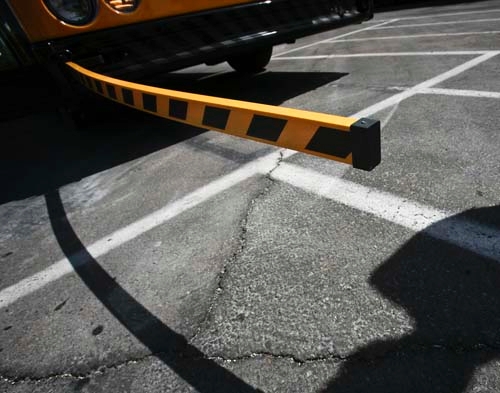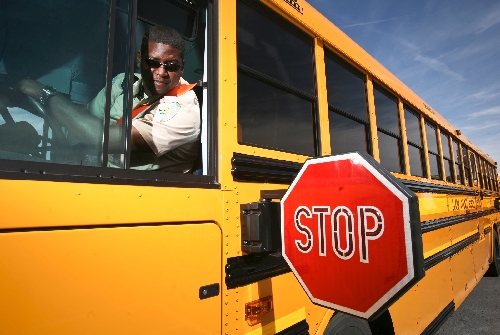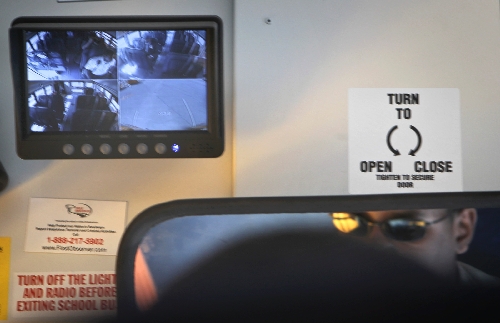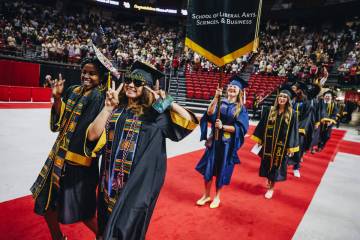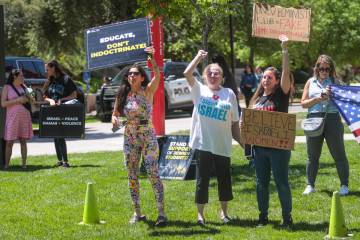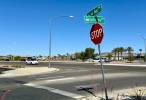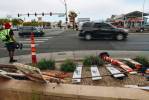School bus fatality causes mother to relive daughter’s ’92 death
It has been 20 years since Brandi Bundy stepped off that school bus in front of her Overton home.
Twenty years since her friends crossed the street before she did.
Twenty years since she followed them, and 20 years since that bus driver drove forward as Brandi crossed the street.
If anyone knows the pain that the parents of Kaylee Derks are feeling, it's Barbara Bundy, whose daughter was struck and killed by a Clark County School District bus in Overton on Jan. 14, 1992.
The death of 11-year-old Kaylee , who was struck by a school bus on March 16, has made Bundy relive her own daughter's death.
"My heart goes out to the driver and to that whole family," Bundy said last week. "I know I still have problems because of it. Yesterday I cried all day at work."
Two decades ago, school buses still lacked some basic safety measures, and Barbara Bundy helped then-Assemblywoman Stephanie Smith spur legislative change mandating potentially life-saving equipment.
School buses still lack some equipment, such as seat belts, a subject that remains hotly debated among experts and school transportation officials. But buses are safer than they've ever been, and pedestrian accidents like those that claimed the lives of Kaylee and Brandi are extremely rare.
"They're the safest mode of transportation there is," said Erin Breen, director of the Safe Community Partnership Program at the University of Nevada, Las Vegas.
Las Vegas police are still investigating Kaylee's death, and several key questions remain unanswered, such as why the bus driver and Kaylee never saw each other.
But when asking whether bus-pedestrian accidents can be avoided, experts say the answer might come down to the same old advice: Parents and children could be more aware of their surroundings.
FROM TRAGEDY, CHANGE
Brandi was 5 when the school bus stopped in front of her Overton home. Some of her friends and older siblings got off and crossed the street.
Brandi also got off. She hesitated, then began to cross the street as the bus driver started to drive away. She was struck by the front of the bus and died instantly.
School bus drivers are required by policy to ensure that all children exiting the bus are safely out of traffic before pulling away, but the driver didn't see Brandi, who might have walked into the driver's blind spot.
The accident was considered the first of its kind for the Clark County School District, and officials reviewed their policies to see if it could have been avoided. Barbara Bundy and then-Assemblyman Warren Hardy proposed a solution: Install arms on the front of buses that would swing out when the bus stopped, forcing students to walk around the arm and into the driver's field of vision.
The school district took up the idea and started installing the arms on its buses. When Hardy lost his re-election campaign to Stephanie Smith, she took up the cause and championed requiring the arms to be installed on all buses statewide.
"It passed unanimously. It wasn't controversial at all," said Smith, who no longer is in the Legislature.
Bundy said, "I'm sure I did save a lot of kids' lives by putting that bar up there," but she's saddened that she couldn't prevent Kaylee's death.
It's unlikely that swing-out arms or other technological devices would have done anything in Kaylee Derks' case, however.
From what witnesses and officials have described, Kaylee was safely dropped off with other students at Ann Road and Pebble Rock Drive, near U.S. Highway 95. Bus driver Leslie Rice's route then required him to turn onto Pebble Rock and into the neighborhood to make a large loop that would let him safely go east on Ann.
The bus struck Kaylee, who was in the street, while making a right turn in the neighborhood. Witnesses said the driver had to navigate parents' cars parked along both sides of the street. Some might have been parked illegally.
A school district spokeswoman said last week that Las Vegas police will likely find the incident was "unpreventable and unforeseeable."
Witnesses said Rice appeared beyond grief after the accident. He remains on sick leave, and a spokeswoman said school district Superintendant Dwight Jones has encouraged him to see a district counselor.
LOW-TECH TRANSPORTATION
While technology has made passenger cars increasingly safe, options like backup sensors, blind spot detection systems, traction control systems and cameras remain rare on school buses.
Dr. Alan Ross, president of the National Coalition for School Bus Safety, an advocacy group, calls current school buses "dinosaurs."
The school district has more than 1,500 buses; about 400 have on-board cameras. The systems include four cameras that can be placed inside or on the back of the bus, with an interactive screen for the driver. Each system adds about $1,500 to the roughly $125,000 cost of a new bus, and all new buses the district buys come equipped with cameras, district transportation Director Frank Giordano said.
About half of those camera-equipped buses shuttle special needs students, who must be dropped off in front of homes and in apartment complexes, where navigating a school bus can be more difficult, Giordano said. With a few exceptions, drivers shuttling the majority of students are instructed never to drop off on private streets and never to drive the bus in reverse.
Buses have large spots where drivers can't see, although mirrors help.
In 2001 and 2002, Ohio received grant money to see if technology, such as ultrasound detection and infrared detectors on the sides of the bus, could remedy the problem.
The systems didn't work well and were prone to false alarms when the sensors became dirty, according to Ohio School Transportation Director Pete Japikse .
"What we discovered is that that technology really didn't do a good job in protecting the students around the bus," Japikse said. "Unfortunately, I don't think that technology has evolved enough to help kids."
Despite the lack of technology, school buses remain relatively safe. A child being struck and killed by a school bus remains rare in Clark County; the Review-Journal could find only three cases, including Kaylee's, in the last two decades.
Since the beginning of the 2009 school year, four Clark County School District students have been struck by buses in accidents the district deemed were "preventable" by driver actions, according to data the district provided. Two other pedestrians were struck in "preventable" accidents. Another five pedestrians, including three students, were struck in "nonpreventable" accidents. The district has not yet ruled on Kaylee's accident.
District buses made nearly 19,000 stops daily and traveled nearly 21 million miles during the last school year.
Nationally, an average of 13 school-age children per year are struck and killed by school buses, according to the National Highway Transportation Safety Administration.
AWARENESS COULD BE KEY
Experts say the behavior of pedestrians plays the largest role in such accidents. Many are caused by students reaching for something they have dropped under a bus or running to catch a moving bus, Japikse said.
In Ohio, students are told to wait at a designated area about 10 steps away from the bus stop. In the morning when the bus arrives, they have to stand there until it stops. In the afternoon when they're dropped off, they are told to go to that area and wait until the bus leaves and is at least a block away.
Students can be disciplined if they don't abide by those rules, Japikse said.
Breen and other experts said pedestrian-involved accidents also could be the result of a society in which fewer young people walk to their destinations. The less walking someone does, the less experience they have around moving vehicles.
"It's so important developmentally for kids to get not just that building block, but that freedom," Breen said.
The school district is reviewing its policies after Kaylee's death. It already has changed the bus route at her stop so that it no longer drives into the neighborhood.
For Bundy, awareness is also key. She would like to see such accidents eliminated so other families don't have to grieve as she did.
She knows there's nothing she can say to Kaylee's parents. Twenty years later, she still feels her own loss.
"Life does go on," she said. "Right?"
Contact reporter Lawrence Mower at lmower@reviewjournal.com or 702-383-0440.



